5 Types Of Live Bait Rigs (That Will Catch Fish Anywhere)
PUBLISHED 03 NOVEMBER 2023
by Robert Ceran
Are you planning to use live bait fishing, but aren’t sure which fishing rig is best for you?
In order to get the best results with this type of fishing, it’s essential to choose the right setup, or you’ll end up wasting your time (in which case you’d be better off throwing lures).
In this article we’ll cover the 5 most important live bait setups, and will discuss how to tie them, how to fish them, and how to choose the ideal setup for your situation.
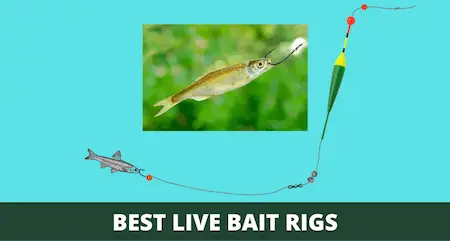
What are the best live bait rigs?
The 5 best live bait rigs are:
- Slip bobber rig
- Carolina rig
- 3 way swivel rig
- Popping cork rig
- Quick strike rig
We’ll go over the pros and cons of each of these live bait fishing rigs in full detail, to help you decide which one is right for your purposes.
We’ll also cover how to set them up, and how to use them for the best results. Read on below to get the full scoop.
Slip bobber rig
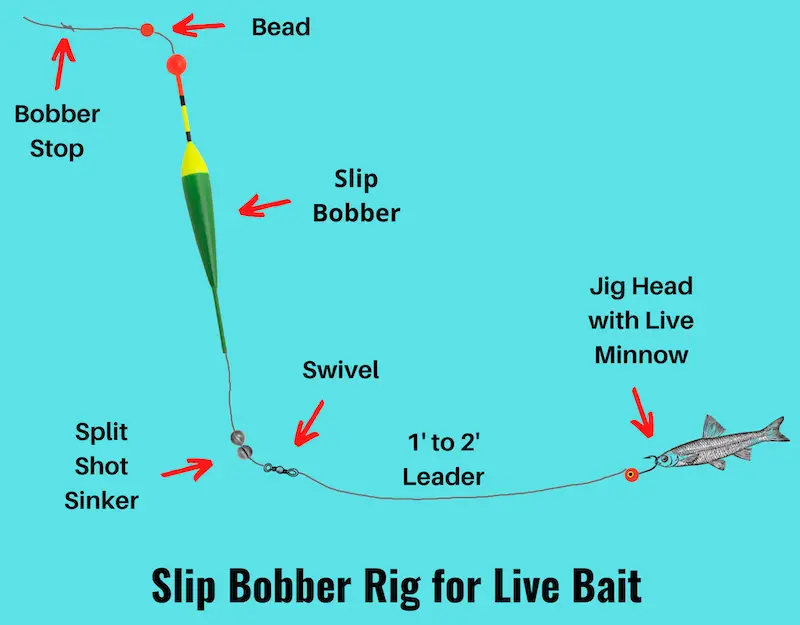
The slip float rig is one of the most versatile and effective live bait setups for both freshwater and inshore saltwater fishing.
Its simple components are easily adaptable, and allow anglers to catch fish throughout the entire water column. This rig should be in every angler’s arsenal.
How to set it up: While this seems like a complex rig, it’s actually quite simple to set up. Start by fixing a bobber stop to your main line. Some people make their own bobber stops, but I prefer to use ready-made ones, which are dirt cheap, easy to use, and work like a charm.
Next, thread on a plastic bead below the bobber stop (this will prevent the stop from getting wedged inside the bobber), and then the slip float itself. In the final step add a split shot or two underneath the slip bobber (as this will stop it from sliding all the way down to the hook), and finish by tying on your hook.
If you want to use a leader (which is usually a good idea when dealing with finicky fish or clear water), tie a swivel to the end of the main line, and then tie the leader (either monofilament or fluorocarbon) to the other end of the swivel.
How to use it: This rig can be used with a wide variety of baits, but is perfect for fathead minnows, shiners or suckers. Use a thin gauge octopus hook and hook the minnow through the front of the mouth, or underneath the dorsal fin.
This live bait setup is deadly for catching everything from walleye, crappie, and trout to bass. The sliding float allows you to target suspended fish at a variety of depths, while the bait dances enticingly in front of them.
You can either use it for stationary live bait fishing, or drift it with the current to find fish holding locations.
When to use it: The slip bobber rig really shines in deep water over 6 feet (which is beyond the reach of traditional fixed bobber setups).
And while a fish finder would be your best option for pinpointing where fish are suspended in deeper water, you can also use this setup to systematically test different depths by moving the bobber stop up or down.
The adjustability of a slip bobber setup allows you to scan the water column until you find a depth at which you start getting bites.
Carolina rig
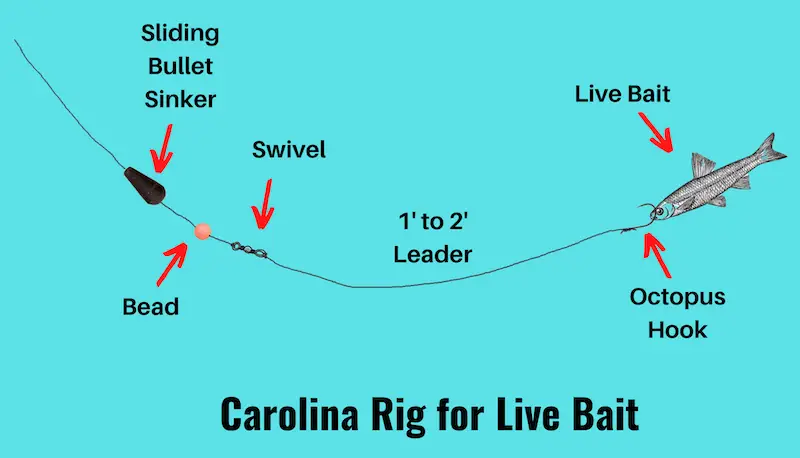
The Carolina rig is perhaps the most versatile and adaptable bottom fishing rig available to anglers, and can be used to catch many different fish species in both freshwater and saltwater.
And while it can be used with a wide variety of baits, the Carolina rig is ideally suited for bait fished on or near the bottom.
How to tie it: Start by threading a sliding egg sinker onto your main fishing line, and then a plastic bead, followed by tying the line to a swivel. The plastic bead is important as it stops the swivel from getting stuck inside the bullet sinker.
Then tie about 12 to 24 inches of fluorocarbon leader to the other end of the swivel, and finish by tying the leader to a size 4 to 10 Octopus hook. Always use thin gauge hooks for live minnows, as they are less cumbersome, and allow the baitfish to move around more actively.
How to use it: Bait your Carolina rig and cast it out to a promising spot. Wait for the weight to sink to the bottom, and then take up the slack line with your reel. Next, place your rod in a rod holder, and wait for bites. You can use a bait feeder spinning reel that alerts you with a loud sound when a fish pulls line off the reel.
If you don’t get any bites, slowly reel in the Carolina rig, letting it settle for a while in several spots along the way, and then cast it out to a different location.
When to use it: You can use this setup to great effect anywhere you want to target fish feeding close to the bottom, which makes it an excellent catfish live bait rig.
It’s also worth mentioning that it’s a great setup for shore fishing, since it’s easy to cast it far and thus reach spots that are out or reach with other setups.
3 way swivel rig
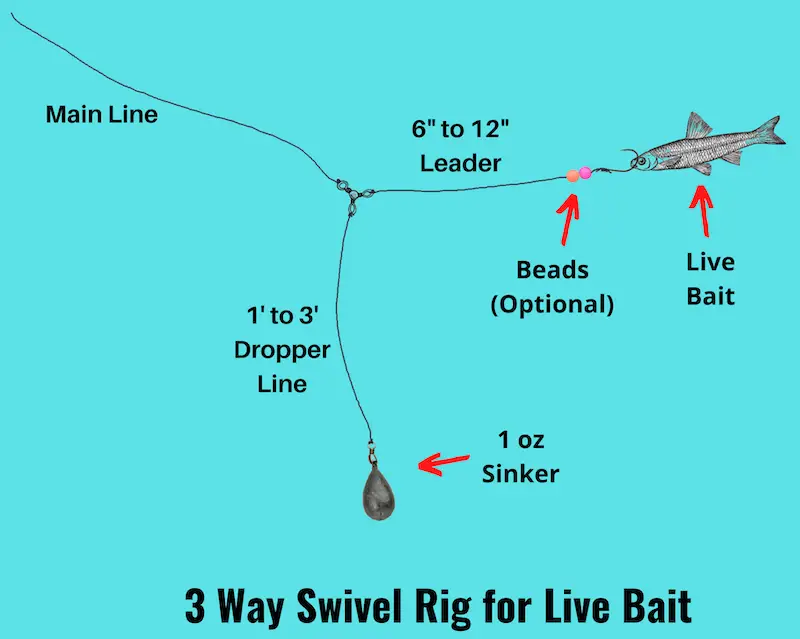
This is another great all-round bottom fishing rig, but comes with the advantage that you can use it for vertical fishing, and if you want to present your live minnow a little above the bottom.
How to tie it: The first step is to tie your main fishing line to a 3-way swivel (I prefer braided main line), followed by tying a 2 to 3 foot dropper line to the eye of the swivel that is opposite the first eye (to which you tied you main line).
At the end of the dropper line tie a 1 to 3 oz weight. Your dropper line should be weaker than the main line by about 10 to 15 lb test, as that will allow you to break it if your weight should ever get snagged on the bottom.
Next, tie a 1 to 2 foot fluorocarbon leader to the eye of the 3 way swivel that’s sticking out sideways (as shown in the image above). Similar to the dropper line, the leader should be weaker than the main line, and for the same reason.
Finally, tie a size 4 to 10 octopus hook to the other end of the leader, and you’re ready to start fishing.
How to use it: The easiest way to fish this setup is to lower it straight down into the water from a boat, a jetty, or a pier. When you feel the line go slack, that means your weight has reached the bottom, and you should then reel in the slack until there is a slight tension on the line, and wait for bites.
When to use it: The 3 way swivel rig is an ideal setup for vertical fishing, which makes it a great live bait rig for saltwater that you can use from a boat, pier, bridge pilings, or rocks. You can also cast it out from the shore, and then take up the slack line to make sure your live shiner is presented slightly above the bottom.
Popping cork rig
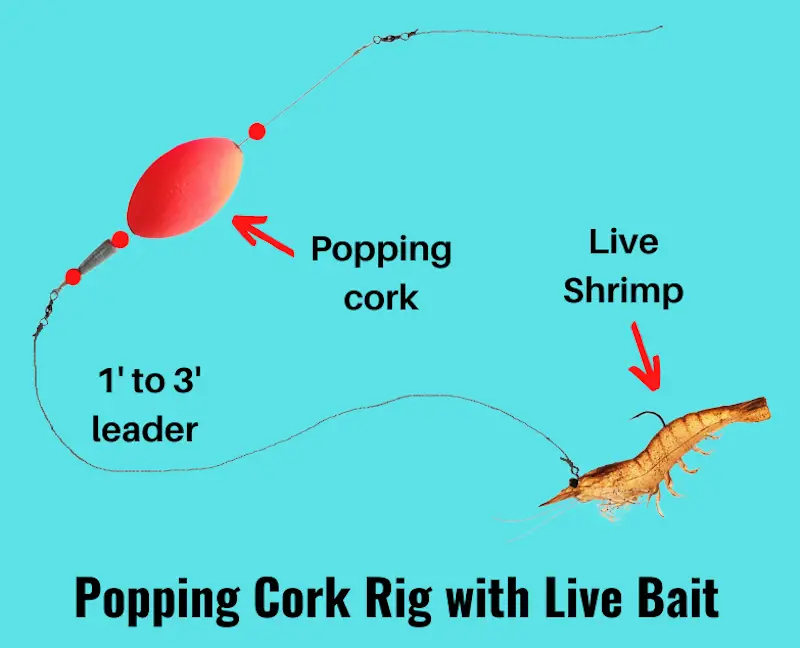
The popping cork rig is a specialized fixed bobber setup that is designed to make popping and splashing sounds at the water surface to attract fish feeding in shallow inshore waters.
The popping cork setup is perfect for live shrimp or baitfish, as the fish attracted by the sounds come closer to investigate, and then fall for the bait moving around underneath the cork.
How to tie it: Start by tying the leader line to your bait hook with a snell knot or uni knot. Then measure out about 1 to 4 feet of leader line, and tie the other end of it to the bottom swivel of the popping cork.
In most cases, it’s best to present your live bait between 6 to 12 inches off the bottom when fishing with a popping cork, so it’s essential to choose the length of your leader to ensure this. Also, add one or two split shot weights above the hook to ensure the bait will stay close to the bottom.
Finally, tie your main fishing line to the upper swivel of your popping cork, and you’re ready to start fishing.
How to use it: Bait the hook with a live mullet, menhaden, or shrimp, and cast it out to a good spot. Often the most promising locations are at the edges of creeks, oyster beds, or drop offs found in creek mouths.
When to use it: The popping cork setup is a deadly inshore live bait setup for redfish and speckled trout in the shallow waters of creeks and shellfish flats. You can use it when you observe feeding redfish, or when you suspect there could be some around.
Quick strike rig
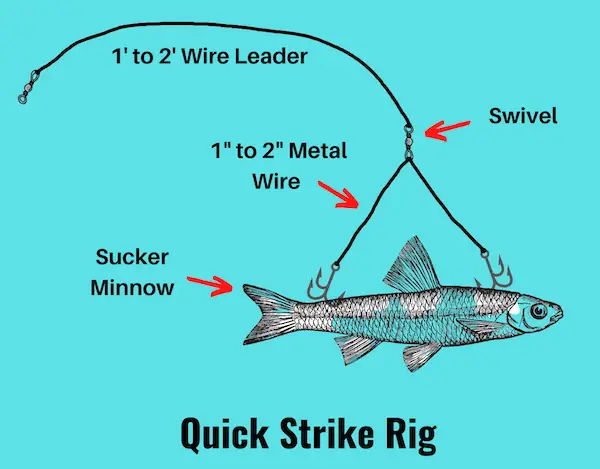
The quick strike rig was originally developed by pike anglers in Europe, and has since been adapted by anglers in North America.
It is most often used for muskie and northern pike, and because these critters have mouths bristling with razor sharp teeth, this setup is usually made with wire (though it can be made with heavy fluoro as well).
How to tie it: The most common version of this setup consists of two large treble hooks that are each attached to the same eye of the swivel with a 2 inch wire. The other eye of the swivel is attached to a longer wire leader that can be up to 2 feet long.
While you can make this rig yourself, an easier option is to buy it ready-made from a tackle shop.
How to use it: By inserting the treble hooks at the tail and head ends of a large bait fish such as a sucker minnow, this rig positions its hooks at both ends of the bait, which allows the angler to strike as soon as a pike grabs the baitfish (hence its name).
When to use it: The quick strike rig is a pike live bait setup that is traditionally used for ice fishing, but has also been adopted by open water anglers in recent years. For open water fishing, suspend it underneath a bobber.
